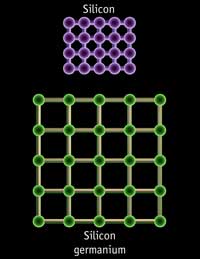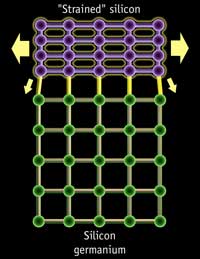Intel's Pentium 4 E: Prescott Arrives with Luggage
by Anand Lal Shimpi & Derek Wilson on February 1, 2004 3:06 PM EST- Posted in
- CPUs
Something to be proud about
Intel is particularly proud of their 90nm process as it incorporates new technologies that are a first in desktop microprocessors. The biggest of them all is the use of Strained Silicon, which we explained back in August of 2002 when Intel first announced that they would use the technology:
Strained Silicon works by effectively stretching the silicon in the channel region of the transistor. The engineers at Intel's fab facilities don't sit there and pull on both ends of the silicon in order to get it to stretch; rather they place the silicon on top of a substrate whose atoms are already spaced further apart than the silicon that needs to be stretched. The result of this is that the silicon atoms on top of the substrate will stretch to match the spacing of the substrate below, thus "stretching" the silicon in the channel.
 |
 |
|
Silicon is "strained" by using a substrate of more widely spaced atoms below the silicon channel of a transistor. (Images courtesy of IBM) |
|
With more well spaced silicon atoms, electrons can now flow with less resistance in the channel meaning that more current can flow through the channel when needed. The end result is a 10 - 20% increase in drive current, or the current flowing through the channel of the transistor.
![]()
Intel claims that their Strained Silicon technology has no real downsides (unlike competing solutions) other than its 2% increase in manufacturing costs. Intel's 90nm process will make use of Strained Silicon technology to improve the performance of their 90nm transistors.
Intel’s 90nm process does not make use of Silicon on Insulator and according to their manufacturing roadmaps it never will. Intel will introduce SOI on their 65nm process in 2005.

Prescott's 112 mm^2 die
Prescott is Intel’s first desktop microprocessor to have 7 metal layers, 2 fewer layers than AMD’s Athlon 64. Intel had to add the 7th layer simply because of the skyrocketing transistor count of Prescott (125 million vs. Northwood’s 55 million). It’s not normally desirable to increase the number of metal layers you have on a chip as it increases manufacturing complexity and cost, but in some cases it is unavoidable. The fact that Intel was able to keep the number of metal layers down to 7 is quite impressive, as AMD had to resort to 9 layers dating back to the introduction of their Thoroughbred-B Athlon XP core to keep clock speeds high.
|
CPU Core Comparison |
|||||
| Code Name |
Willamette |
Northwood |
Northwood EE |
Prescott |
AMD Athlon 64 |
| Manufacturing Process |
0.18-micron |
0.13-micron |
0.13-micron |
90 nm |
0.13-micron |
| Die Size |
217 mm^2 |
131 mm^2 |
237 mm^2 |
112 mm^2 |
193 mm^2 |
| Metal Layers |
6 |
6 |
6 |
7 |
9 |
| Transistor Count |
42 Million |
55 Million |
178 Million |
125 Million |
105.9 Million |
| Voltage |
1.750V |
1.50V |
1.50V |
1.385V |
1.50V |
| Clock Speeds |
1.3 - 2.0GHz |
1.6 - 3.4GHz |
3.2 - 3.4GHz |
2.8 - 4GHz+ |
2.0GHz+ |
| L1 Instruction/Trace Cache | 12K µops |
12K µops |
12K µops |
12K µops |
64KB |
| L1 Data Cache | 8KB |
8KB |
8KB |
16KB |
64KB |
| L2 Cache | 256KB |
512KB |
512KB |
1MB |
1MB |
| L3 Cache | N/A |
N/A |
2MB |
N/A |
N/A |










104 Comments
View All Comments
Jeff7181 - Sunday, February 1, 2004 - link
I'm going to go out on a limb here and say 2004 is the year of the Athlon-64 and Intel will take a back seat this year unless their new socket will help increase clock speeds. When AMD makes the transition to 90nm I think you'll see a jump in clock speed from them too... and I'm willing to bet their current 130nm processors will scale to 2.6 or 2.8 Ghz if they want to put the effort into it before switching to 90nm.Intel better hope people adopt SSE3 in favor of AMD-64 otherwise they're going to lose the majority of the benchmark tests.
On second thought... the real question is how high will Prescott scale... will we really see 4.0 Ghz by the end of the year? Will performance scale as well as it does with the Athlon-64?
Right now, looking at the Prescott, the best I can say for it is "huh, 31 stages in the pipeline and they didn't lose too much performance, neat."
Barkuti - Sunday, February 1, 2004 - link
Check out the article at xbitlabs:http://www.xbitlabs.com/articles/cpu/display/presc...
Less technical but with a wider set of tests.
Stlr22 - Sunday, February 1, 2004 - link
;-)Stlr22 - Sunday, February 1, 2004 - link
((((((((((((((CRAMITPAL))))))))))))))))Listen,I just want you to know that everything will be alright. Really, life isn't all that bad buddy. It's not good to keep so much hate inside. It's very unhealthy. We are all family here at the Anandtech forums and we care about you. If you ever need to sit down and talk, I'm ll ears pal. So that your brother doesn't feel left out, here's a hug for him aswell.......
(((((((((((((AMDjihad)))))))))))))
KF - Sunday, February 1, 2004 - link
Yeah, the Inquirer was right about 30 stages. Maybe I should start reading it! However I did read the one where the news linked to an article purporting that an Inquirer reporter had bumped into a person who had overheard an Intel executive say Prescott was 64 bit. Maybe Derek and Anand didn't have the space to squeeze that tiny detail into the review.I saw a paper on the Intel site a while ago, seemingly intended for some professional jounal, the premise of which was that it is ALWAYS preferable to make the pipeline longer, no matter how long, while using techniques to reduce the penalties. Like, 100 stages would be a good thing. Right then I knew what one team at Intel was up to. The fact that they didn't explain any new penalty reduction techniques only made it all the more sure what Intel had in the works (otherwise why write the paper?), and that they had the techniques worked out, but still under wraps.
ianwhthse - Sunday, February 1, 2004 - link
Err.. *CramitpalSorry about that. My mind is wandering.
ianwhthse - Sunday, February 1, 2004 - link
Did we actually just get 26 good posts in before crumpet showed up?FiberOptik - Sunday, February 1, 2004 - link
I like the part about the new shift/rotate unit on the CPU. Does this mean that prescott will be noticeably faster for the RC5 project? Athlon's usually mop the floor with whatever the Northwood can pump out.eBauer - Sunday, February 1, 2004 - link
"Botmatch has bots (AI) playing, shooting, running, etc. (deathmatch) while Flyby does not. The number that you should be most interested in is the Botmatch scores."No, I am talking about the botmatch scores from previous articles. Well aware of the difference between flyby and botmatch. http://www.anandtech.com/cpu/showdoc.html?i=1946&a... In that article, all CPU's had about 10 more fps than the CPU's in the prescott article.
AnonymouseUser - Sunday, February 1, 2004 - link
"I am curious as to why the UT2k3 botmatch scores dropped on all CPU's... Different map?"Botmatch has bots (AI) playing, shooting, running, etc. (deathmatch) while Flyby does not. The number that you should be most interested in is the Botmatch scores.